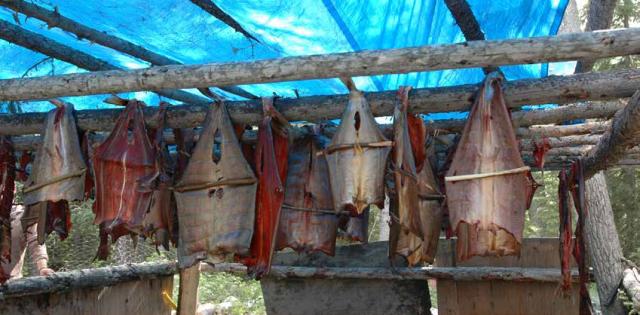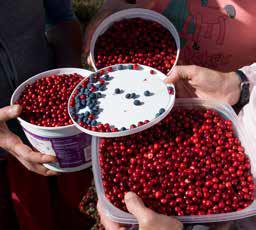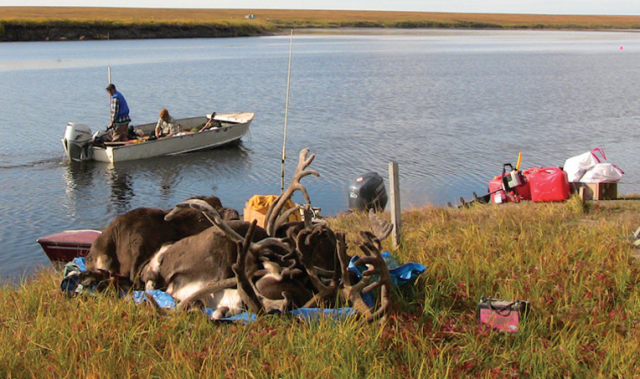You are viewing ARCHIVED content published online before January 20, 2025. Please note that this content is NOT UPDATED, and links may not work. Additionally, any previously issued diversity, equity, inclusion or gender-related guidance on this webpage should be considered rescinded. For current information, visit https://www.blm.gov/blog.
More than survival, the subsistence tradition sustains meaning for rural Alaska Natives and non-native residents alike

In many parts of Alaska, wild food isn’t a sport, but rather necessity and culture. For rural Alaskans, be they Alaska Natives with cultural and spiritual ties to the land going back millennia or people who heeded the call of the frontier to live far from stores, cash-paying jobs, and the state’s few roads, subsistence is part of what defines them. Wild resources are spiritual, cultural, social, and economic necessities.
Of course, many urban Alaskans with access to commercial food and goods still place a high value on harvesting from the wild. But “a subsistence lifestyle” is living off -- and with -- the land on multiple levels, and it is the only option for many rural residents of the largest U.S. state. It defines them and perpetuates the legacy of what many would say illustrates who Alaskans truly are.
In fact, Alaska is the only state where the federal government manages public lands and waters for subsistence -- about 230 million acres, or 60% of the land in the state – prioritizing and preserving this sacred way of life.

gathering and using wood, antlers,
mushrooms, berries, grasses, and other
plant materials in a lifestyle that includes
sharing harvests among family and
neighbors, especially those with smaller
harvests. Harvesting berries like these
cranberries provides a good source of
vitamin C to use through the long
winter ahead. BLM photo by Craig
McCaa
Today, Alaska’s rural residents each harvest an average 295 pounds of wild foods every year, or about 18,000 tons, with fish making up about 56 percent of those harvests, according to the Federal Subsistence Management Program, which is responsible for balancing harvest with healthy wildlife populations.
Fishing for many rural Alaskans means using a fishwheel, dipnet, seine, or gillnet to capture and store much-needed protein for the year with federal harvest limits that are generally based on a household’s annual needs. This can be higher than a sport fisher’s daily bag limit of a few fish.
While five BLM Alaska field offices issue hunting permits in Game Management Units (GMUs) on lands they manage, the Glennallen Field Office alone issues a whopping 65%, of all federal subsistence wildlife harvest permits issued annually in Alaska. With more than 4,000 permits issued on average for moose or caribou across a 770,000-acre swath of land called GMU 13, federal subsistence harvesters consistently take about 350 caribou each year.
But subsistence also includes gathering and using wood, antlers, mushrooms, berries, grasses, and other plant materials in a lifestyle that includes sharing harvests among family and neighbors, especially those with smaller harvests.
Because life in rural Alaska often depends on filling pantries and freezers, their seasons are often defined more by what subsistence foods can be optimally searched for, gathered, and preserved than anything else. In a land where winter dominates, every facet of life can be woven into a subsistence lifestyle and the continuation of who Alaskans are as a people.
“[The term] subsistence alone doesn’t encapsulate what it really means culturally and spiritually to rural Alaskans and particularly Alaska Natives,” said BLM Alaska Subsistence Coordinator Chris McKee. “It’s hard to define generally; its more than hunting, fishing and collecting berries, though that’s one component.”
That’s why Alaska is the only place in the nation where living this way is legally protected by both the state and federal governments.
Protections in a nutshell
To McKee’s point, the 1980 Alaska National Interest Lands Conservation Act (ANILCA) prioritized subsistence use of fish and wildlife on federal lands for rural Alaska residents as “essential to Native physical, economic, traditional, and cultural existence and to non-Native physical, economic, traditional, and social existence.”

In ANILCA, Congress specified its intent to safeguard the continuation of “...customary and traditional uses by rural Alaska residents of wild, renewable resources for direct personal or family consumption as food, shelter, fuel, clothing, tools or transportation; for the making and selling of handicraft articles out of nonedible by-products of fish and wildlife resources taken for personal or family consumption; and for the customary trade, barter or sharing for personal or family consumption.”
In a nutshell, the law ensures on federal lands in Alaska that:
- Priority for fish and wildlife harvest goes to rural Alaskans for subsistence.
- Rural residents and their traditional knowledge play a meaningful role in subsistence management.
- Potential subsistence impacts are considered and addressed in land management and use decisions to maintain customary and traditional subsistence uses.
Priority
Congress intended State subsistence management on all lands with federal funding and compliance oversight. However, federal management on federal lands began in 1989 after the Alaska Supreme Court determined the rural priority on state land violated its constitution. This ruling qualified all Alaska residents for subsistence permits under Alaska law, while rural subsistence hunters retain priority on federal lands under federal subsistence laws.
To better manage the diverse wildlife species across such a vast state, Alaska is divided into 26 GMUs. Since the GMUs are often based on natural environmental boundaries like mountains and streams instead of lines on a map, they can contain a mix of privately owned, state, federal, regional, and Native village corporation or Native allotment lands. Like the units themselves, federal and state hunting regulations for each GMU are unique, and both sets of regulations may include distinct prescriptions for harvest methods and means, bag limits, and access.
This “dual-management” approach means state fishing, hunting, and trapping regulations apply on non-federal lands and, in general, all Alaska residents are eligible to hunt under the state regulations. State regulations also apply on federal lands unless they are specifically closed to non-Federally qualified users.
Federal subsistence regulations, on the other hand, apply only on federally managed lands and dictate where only rural Alaskans may fish or hunt using those regulations. Federal subsistence regulations give rural hunters priority on federal lands when there is a difference in the regulations.

For example, under this dual-management structure, the State often runs a hunt for the same species in the same area as a federal subsistence hunt. The difference for the federally qualified subsistence hunter using federal subsistence regulations might be a longer hunting season, a bigger harvest limit, or a more liberal means of access (like using off-highway vehicles when others can’t) than an urban-based hunter using state regulations., This creates complex management and enforcement challenges requiring lots of cooperation and coordination among state and federal managers.
Rural Resident Involvement
A rural Alaska resident chairs the decision-making Federal Subsistence Board overseeing the federal program with two rural residents as voting board members – all appointed by the Secretaries of Agriculture and the Interior. Regional or state directors from the National Park Service, Bureau of Land Management, U.S. Fish and Wildlife Service, Bureau of Indian Affairs, and the U.S. Forest Service round out the board as voting members.
“The involvement of rural Alaskans is essential to the successful management of the Federal Subsistence Management Program,” said Acting BLM State Director Tom Heinlein. “Rural voices represent first-hand knowledge of resource conditions and trends that are critical to sustaining subsistence resources.”
10 Regional Advisory Councils also ensure local input from all regions of Alaska is considered. Their recommendations about taking fish and wildlife on federal public lands can be vetoed only under very specific circumstances.
Potential Impacts Considered
Section 810 of ANILCA requires that Federal agencies evaluate the potential effects of projects on subsistence needs and consider ways of reducing those effects. That means for each action requiring analysis under the National Environmental Policy Act (NEPA) in Alaska, an accompanying ANILCA Section 810 Evaluation is conducted by staff biologists and/or anthropologists.
Projects expected to significantly restrict subsistence uses require public hearings in affected communities with determinations made regarding the project’s necessity, the minimum public lands needed, and steps taken to reduce impacts.
“Because subsistence is particularly significant to Alaska Native peoples, the BLM relies on independent consultations with Federally recognized tribes and ANSCA (Alaska Native Claims Settlement Act Corporations,” McKee said. “BLM Alaska’s Subsistence Program also relies heavily on its relationship with Native communities to inform its understanding and management of subsistence resources.“ Find more information on the Federal Subsistence Management Program, including how qualified residents can apply to be considered for membership on the Subsistence Advisory Council, at https://www.doi.gov/subsistence.
Eric Tausch
Related Stories
Office
222 W 7th Avenue #13
Anchorage, AK 99513
United States
